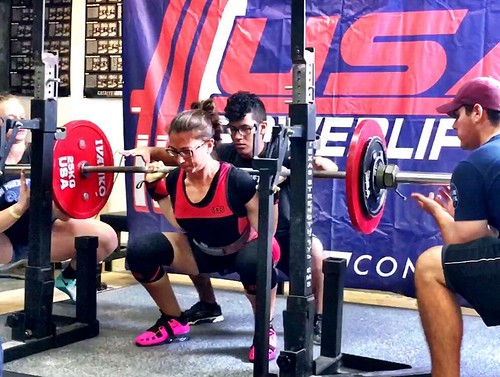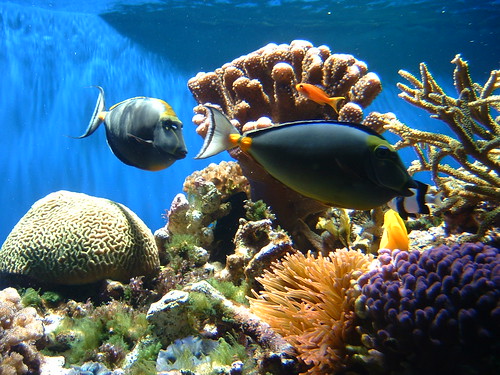Anyone who comes across any of my social media accounts (especially instagram) recently would notice right away that I have fallen in love with lifting heavy weights, and more specifically the sport of powerlifting. So much so that I’ve created a whole new blog, called Learning to Lift, where I’m sharing my learning journey with powerlifting.
But it wasn’t until a few weeks ago, right after the Learning2 conference in Shanghai, that I realized how many essential digital literacy skills I’ve been applying over the last few years, in my quest to lift heavier weight. At first, it might seem kind of strange to connect digital literacy with fitness, but actually, when you step back for a moment, one of the biggest industries designed to intentionally confuse consumers is the fitness industry, so literacy can be crucial.
At Learning2, I gave a 5-minute talk about the ways that powerlifting helped me change from a bad math student to an empowered and engaged learner. If you’d like to watch it, here it is:
And it wasn’t until a week after, when I was working with teachers at Dulwich International High School in Suzhou that I realized that one of the reasons I was able to build my math skills through powerlifting was because I had the essential critical literacy skills needed to be a successful independent learner.
You see, the world of fitness is full of misinformation, misleading information, fads, and straight up falsehoods. It’s pretty much designed to be that way to make losing weight and getting fit harder than it actually is, so that you buy all sorts of products to help you achieve your goals, without ever really understanding how things work. Little did I realize that along with my math skills, I was putting my critical literacy skills to work over the last few years in building my knowledge about lifting and nutrition.
Developing Critical Literacy Skills
In looking back at that experience, I realized that there is a two-phase process to develop the critical literacy skills that I have been using – and we can easily bring them the classroom to help our students be successful learners in a media rich world. Here they are:
Phase 1: The CARP Test
This is where it all begins! Often the journey into a personal passion might start with a one-off research project for school, or a quick dive into a specific topic for a purpose. And for that kind of focused research, the acronym CARP has it all. CARP stands for Currency, Accuracy, Reliability and Purpose, and can be quickly and easily applied in any context. This is a great starting point for building critical literacy skills with students.
Check out a more detailed description here on the Eduro Learning blog, and if you’re looking for additional resources for your classroom, including a perfect infographic to put up, a video on how to teach the CARP test method to students, and some printable resources you can use with your students, check out this resource pack we created for teachers!
Often, when we’re thinking of critical literacy skills and what we need to teach our students, we stop here. But, I think we can go even deeper. This is where my current passion for powerlifting has helped me realize how many more essential critical literacy skills we have to learn (and practice) to be successful in our media rich world.
Phase 2: Developing Your Learning Ecosystem
Perhaps one of the most cliche things I say (and also truly believe) is that I want my students to be lifelong learners. It may be cheesy, but whether I’m working with young people or adults, the most important thing they learn is how to learn – about anything, for as long as they want, without being misled or misinformed. And this is what having a “learning ecosystem” is all about. This is where the critical literacy skills we know and love from the CARP test get amped up into an individualized dynamic learning environment.
Here’s how it works:
1: Build Your Network
Start by finding one person who is a visible and reputable expert in the field (use your CARP experience to find the right person) and add them to your Personal Learning Network using whatever tool works for you (maybe you want to read their book, or their website, or follow their blog, their Twitter, or their Instagram – it doesn’t really matter). In my powerlifting journey, my first person was Bret Contreras and his Strong Curves book, recommended by a friend, Mithra Ahsef, in the summer of 2012.
Then, put your PLN building skills to the test and see who that person references in their work, and follow them in as many places as feels comfortable for you. Keep following the people those people reference, and so on, until you have established a base circle of experts.
Follow these experts in whatever space works best for your learning style. Over time, I’ve noticed that the fitness experts I follow are most active in Facebook, Instagram and YouTube. Actually, I’m sure they’re all on Snapchat too, but I just can’t. Yet.
As you are seeing the work they share, you may start to notice the connections between their ways of thinking – where they align and where they differ. At this point, you might also consider following (or at least reviewing) some of the work that your circle of experts disagrees with. Keeping yourself informed from all different perspectives is not easy, but you also don’t want to find yourself in an echo-chamber of exclusively the same information.
While you’re building this network, and determining who you want to keep up with, try to reach out and interact with them to make a personal connection. You might start with simply leaving comments or replying to threads. Over time, you might find that you can actually talk to your experts on a regular basis!
2: Mix and Match Sources
This may be the most important step: use a variety of media sources in building your learning ecosystem. This is critical for a few reasons, first because different media sources may have different levels of authority (published books vs blogs for example), but also because different experts also tend to gravitate towards different media that suit their teaching style best.
For example, I have a number of powerlifting experts who I follow on YouTube almost exclusively because this is where their best content is (if you’re curious, check out my resource page on my Learning to Lift blog). There are others who I almost exclusively read in book form, others who I listen to on podcasts, and still others who I regularly interact with on Facebook and Instagram. None of these formats are wrong, but if I didn’t use one of them, I might be missing out on some great learning opportunities.
The idea here is to ensure that you’re building a learning ecosystem that consists of a wide variety of sources, because each one of those sources might be best suited to a certain kind of learning. You might find YouTube extremely helpful for instructional videos that need a visual element, or podcasts especially powerful to expose you to new ideas and new experts in the field. And we all know that books are great for deep learning on a specific content. Blogs, websites and other forms of social media help us stay up to date so we know what’s new in our field of interest on a regular basis. Bring all of these elements together and you have an ecosystem that’s designed specifically for you, providing the best content in all the various formats we have access to.
3. Find the Connections
As you’re reading, watching, listening and interacting, you’re going to start to see some interesting things:
- You will begin to notice the connections between these individual experts because you will see who references whom, what they respect about each other, when and why they turn to someone else and when they turn away.
- You will begin to recognize who is an authority in what aspect of your chosen field. For example there are some experts in nutrition who also lift, but it’s clear from the other experts in the field that their training protocols are not ideal, whereas their nutrition information is on point.
- You will begin to uncover their personal bias and perspective about your field of interest, which will enable you to make better choices about what aspects of their expertise you choose to follow, vs what you leave behind.
As you start to understand the depth of knowledge of each individual expert a little bit better, you’ll start to see where they overlap and how each person is connected to each other. It’s almost like you have a window into their personal learning network. This is probably the most powerful part of the learning ecosystem. Because now it’s almost like their PLN has become your PLN.
Although you might not be interacting with these professionals on a daily basis, like you would your own PLN, you can very easily use their expertise to filter the information you find and use. If someone from this expert group references a new article, book, or expert, you will know right away whether they are established and respected, and can add them (or not) to the list of people you’re already following. This is how you can keep your learning ecosystem expanding almost endlessly. And most importantly, this is how you can filter what you read, see and hear. This is the essential critical literacy element that, for many students (and adults), is missing. This is how we can use our personal network of experts to actually know if what we’re seeing online is true or not – without having to do all of the research ourselves.
4. Consolidate Your Learning
As you’re building this learning ecosystem, you are probably going to find yourself awash in both resources and new ideas. We all know there is so much to learn online, and when you have identified a passion you not only want to keep and organize what you learn, but you might be interested in sharing it with others too.
This is the perfect opportunity to use tools, like Flipboard or Pinterest, to curate all of the great content you see. This will let you create a personalized textbook of all of the resources you know you might want to review again – and perhaps share with others. In the classroom, this curated content would be a great resource to have students share with their teacher, so you both have an idea of the types of articles and media the student is using to further their understanding. In a personal setting, you might find that other friends share an interest or passion, and you can easily share your curated magazine or pinboard with them too. (By the way, if you’re at all interested in powerlifting or nutrition for performance, check out my flipboard magazines!).
As you’re collecting all of those resources for yourself, you might find that you are seeing connections and building new understandings. One of the best ways to demonstrate that understanding, and to really consolidate your thinking, is to share that learning. Just sharing the curated articles is a start, but making sense of those connections through more thoughtful artifacts like blog posts (or vlogs or even longer form instagram posts) is a great way to reflect on your learning and document your thinking in a place you can reference, for yourself and for others.
It may seem like a lot of extra work to thoughtfully document your learning on a platform like a blog, but after having this blog for almost 12 years, I can not count the number of times I’ve come back to an old post to refresh my memory or share a deeper understanding. If you’re truly passionate about a topic, you will likely want that external mental archive of your learning for later reference. And for students, this would make a great portfolio of learning to use in applying for university admission, or even an internship!
5. Have a mentor or coach
In developing this learning ecosystem, you might find that some of the resources that you find might be a bit beyond your reach. In this case, it can be very helpful to have a mentor or coach who is slightly further along than you are. In my quest to lean up, but not lose strength I had a good foundation about nutrition, but I simply did not know enough to make sense of some of the more complicated information I was finding. So, I hired an online nutrition coach (and if you’re looking for a vegan, powerlifting nutrition coach with a PhD, I can highly recommend Anastasia, she’s amazing!).
Over the course of six months, Anastasia helped me build my own understanding so that I could continue taking one step forward at a time, as my learning progressed. Her support was the exact kind of “just in time” learning that we often talk about when using technology, and I now feel much more prepared to make good nutrition decisions on my own. But, I definitely appreciate the fact that I know I can work with her again in the future if I need further support.
For our students, it’s unlikely we’ll be expecting to pay for the services of a coach, but often when working with younger learners, even experienced professionals will donate their time. It’s always worth asking!
In addition to these more experienced experts that we can tap into, it’s also possible, even likely, that you will find other learners a little farther along the path than you are, who are more than willing to take the time to share their experience with you. You may find them in places like Facebook groups, or Reddit forums, or even Instagram pods. It’s worth cultivating these connections so that you can more readily receive feedback and inspiration right at the level and depth that you need in your personal learning journey.
Personalizing Critical Literacy in the Classroom
As a teacher, my goal has always been to help my students learn how to learn. To be inquisitive, to find their passion, and to keep on learning – even when they’re not required to do so for school purposes. I think every student has an interest or a passion that they can deeply explore, and many times those passions can lead them through their academic journey. If we can help students find and develop that passion by building critical literacy skills, we are setting them up for success for life!
Not only will they be able to be a lifelong learner, as cheesy as that may be, but they will also have the skills to tell truth from fiction in our media rich world, and be able to share that learning with an network of other learners.
It seems almost expected now, but I have to admit, I was a little surprised that all my technology coaching, personal learning network building, and critical literacy skill development over the last 17 years in education has prepared me very well to be successful in navigating the world of fitness!
My big takeaway from this experience is that it’s even more important than I have always thought to be teaching these skills to our students. And that when we tap into individual student passions, we can bring in the key critical literacy skills we need to be successful in today’s world, in a way that is both engaging and purposeful for our students.
What do you think?
Are you following a passion? Do you have a learning ecosystem? How does it work for you? How are you helping your students develop these environment for their own learning?
Photo Credits
- Coral Reef at Palmyra Atoll by USFWS Pacific, CC licensed on Flickr
- 6 months of hard work, by superkimbo, CC licensed on Flickr
- carp, by moriakimitsuru, CC licensed on Flickr
- Linked, by Cali4beach, CC licensed on Flickr
- The Candy Man Can, by chris.vandyck, CC licensed on Flickr
- coral reef, by only_point_five, CC licensed on Flickr
- Gallery by hernanpba, CC licensed on Flickr
- Last Words from the Coach, by mikecogh, CC licensed on Flickr
- Calcutta Coffee House, by lecercle , CC licensed on Flickr













